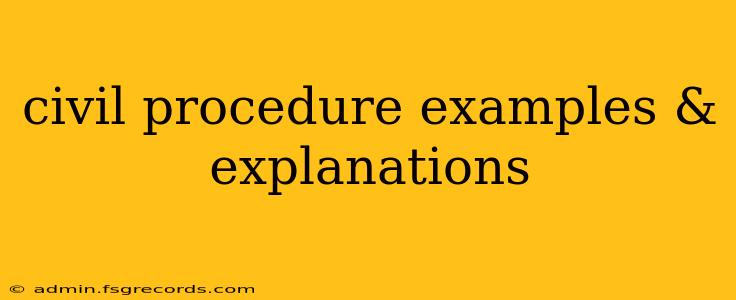Navigating the complexities of civil procedure can feel like traversing a dense legal jungle. This guide provides clear examples and explanations to illuminate the key stages and concepts, demystifying the process for both legal professionals and interested laypersons. Understanding civil procedure is crucial for anyone involved in, or simply curious about, civil litigation.
What is Civil Procedure?
Civil procedure encompasses the rules and regulations governing civil lawsuits. It dictates how a case proceeds from initial filing to final judgment, outlining the steps involved in resolving disputes between individuals, organizations, or both. These rules aim to ensure fairness, efficiency, and due process for all parties involved.
Key Stages in Civil Procedure with Examples:
1. Pleadings:
This initial stage lays the groundwork for the lawsuit. The plaintiff files a complaint, outlining the claims and seeking specific relief. The defendant then responds with an answer, admitting or denying the allegations.
Example: Imagine a car accident. The plaintiff (injured driver) files a complaint alleging negligence against the defendant (other driver), seeking damages for medical bills and pain and suffering. The defendant's answer might deny negligence, or admit some fault but argue for reduced damages. A counterclaim might be filed by the defendant if they also believe the plaintiff was at fault.
2. Discovery:
This phase allows both sides to gather information relevant to the case. Methods include:
- Interrogatories: Written questions requiring written answers under oath.
- Example: "Please list all witnesses to the accident."
- Depositions: Oral examinations of witnesses under oath, recorded by a court reporter.
- Example: A deposition of an eyewitness to the accident, questioning their observations and memory of events.
- Requests for Production: Demands for documents or other tangible evidence.
- Example: A request for the defendant's insurance policy or repair records for their vehicle.
- Requests for Admission: Requests to admit or deny specific facts.
- Example: "Please admit that you were driving the vehicle involved in the accident on [date]."
3. Motions:
Throughout the process, either party can file motions requesting court orders. Common motions include:
- Motion to Dismiss: A request to dismiss the case due to procedural defects or lack of legal merit.
- Example: The defendant might file a motion to dismiss if the complaint fails to state a valid legal claim.
- Motion for Summary Judgment: A request for judgment without a trial if there are no genuine disputes of material fact.
- Example: If the defendant has irrefutable evidence proving they were not at fault in the accident, they might file a motion for summary judgment.
- Motion in Limine: A request to exclude certain evidence from the trial.
- Example: A motion to exclude irrelevant or prejudicial evidence.
4. Trial:
If the case doesn't settle, it proceeds to trial. This involves presenting evidence, examining witnesses, and providing closing arguments. The judge or jury then renders a verdict.
Example: In our car accident case, the trial might involve testimony from the plaintiff and defendant, expert witnesses (e.g., accident reconstructionist), and presentation of medical records and police reports.
5. Judgment and Appeal:
The court enters a judgment based on the verdict. The losing party can appeal the judgment to a higher court, arguing legal errors were made during the trial.
Understanding the Importance of Procedural Rules:
Civil procedure rules are not merely technicalities; they are fundamental to ensuring a fair and efficient legal system. They protect the rights of all parties, promote the orderly resolution of disputes, and preserve the integrity of the judicial process. Failure to follow these rules can lead to significant consequences, potentially resulting in dismissal of a case or reversal of a judgment.
This guide provides a basic overview. The specifics of civil procedure can vary considerably depending on the jurisdiction and the nature of the case. Consulting with a legal professional is always recommended for advice on specific situations.

